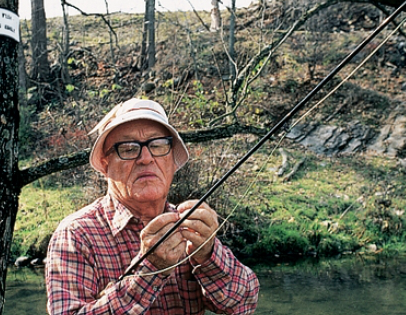
Yellow Breeches Creek, located in southcentral PA one of the most famous trout streams in the country
Central Pennsylvania’s ubiquitous crystal clear mountain streams are one of the state’s natural gems. The cool springs that feed them provide a year-round nearly constant water temperature and the limestone beds of these creeks produce a slightly basic environment in which trout thrive. Pennsylvania has some of the most famous trout streams in the world, and every year anglers flock to the wilds of PA in pursuit of trout.
Trout have become an exceedingly popular “game fish” for many reasons. First of all, they are delicious. There is nothing better than pan fried trout fillets with lemon or tartar sauce. Secondly, They are beautiful fish. Our State fish, the brook trout, is an incredible creature. Its brown body is spotted and has a slight red tinge to its underbelly and a magnificent iridescence to its skin. There is hardly a prettier fish to be found in PA’s waterways. Lastly, they are smart. Trout live most of their lives in clear, shallow streams and feed mainly on aquatic insects and their larvae. This means that they are incredibly wary and difficult to catch. One of the most popular methods of taking trout is fly fishing, a technique of fishing in which the angler uses artificial flies to catch trout on small hooks.
Long before Penn State was Linebacker U, we were legendary for a very different sport, fly fishing for trout. In the world of fly fishing, Penn State still holds the top rank. This is due to the work of a man named George Harvey.
Harvey is somewhat of a Penn State Legend. Born in DuBois in 1911, he spent much of his childhood in the woods and in the creeks of Central Pennsylvania. As a kid, he honed his fishing skills by fishing with a stick and line to feed his family. He came to Penn State in 1930, and as a freshman, befriended the dean of the college of agriculture, Ralph Watts.
Watts, an avid fly fisherman, agreed to take Harvey fishing one morning on Spring Creek and after a little over an hour the frustrated dean declared that the fish weren’t biting and was ready to head home. Harvey, on the other hand had caught his limit of 16 fish including several that were too big to fit in his creel so he had to carry them back in his hunting jacket. Watts was so stunned at George’s uncanny ability to catch fish that George became his personal fishing mentor. Soon other professors took notice of the gifted undergraduate and he became the resident expert on fly fishing, he even started his own unofficial fly tying and fishing class.
After graduation, Harvey moved to Penn State’s Mont Alto School of Forestry to continue teaching before moving the course back to University Park in 1942. In 1947 “the Principles and Techniques of Fly Fishing and Fly Tying” and became an officially credited course, the first of its kind.
George Harvey passed away in 2008 but his legendary class lives on here at Penn State. This semester I am taking KINES 004, “Principles of Fly Tying and Fly Fishing for Trout” taught by Greg Hoover. It is a fascinating course. Hoover, as an entomologist really enforces the scientific nature of fly fishing. He stresses the importance of tying flies to accurately mimic aquatic insects in various life stages, and the importance of matching the trout’s food source (which varies drastically depending on time of year) with the fly you are fishing.
Hoover also stresses the importance of water conservation, and how fishing pressure and pollution threaten stream ecology. Aquatic insects are excellent indicators of water quality. The biodiversity and abundance of these bugs in our local streams is a microcosm for the entire biosphere. If we allow poisonous pesticides and nitrogen-rich sewage to get into our waterways and kill off the bugs and the fish, what does that mean for us?



I never knew that Penn State offered such a class, but I think that it is awesome and I may try to take it. I know that back where I live fly fishing is very popular in Valley Forge Park. I see someone standing in the lake of stream every time I go there. I also think that fly fishing is really a testament to human ingenuity. It is very clever that someone some up with the idea to mimic an animals natural food source.
I thought the change of pace with this blog post was pretty cool. This George Harvey guy almost sounds like an urban legend. Catching 16 fish is pretty absurd, but then again, I wasn’t there to dispute it, so I’m not in any position to judge the factuality of the story. I liked the point you made at the end about conserving the local waters. My father is on the Conservation Commission in my hometown and recently fought the town in building an animal shelter next to a stream that is home to a breed of trout that is rapidly declining. Ultimately, the Legislative Council did not listen to the Conservation Commission’s recommendation to build the shelter somewhere else, where the construction would have less of an impact, much to my father’s dismay. Hopefully things will be different in the future.
I had no idea this was such a big thing here, but Harvey sounds like quite a man and I’m glad his legacy lives on here. I’m not a big fisher myself, but my grandpa is an absolute wizard when it comes to fishing; whenever he visits I’ll go out with him to watch the master at work and it is pretty amazing. I’ve never really gotten in to fishing, but it might I enjoy spending that time with my grandpa every year or so.